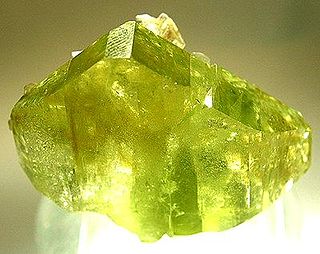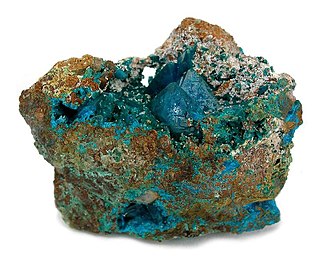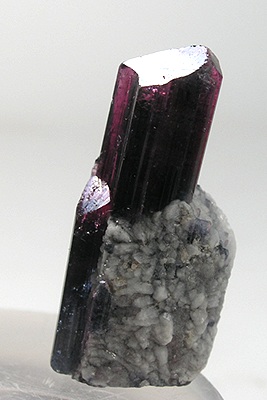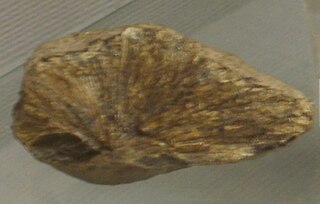
Brazilianite, whose name derives from its country of origin, Brazil, is a typically yellow-green phosphate mineral, most commonly found in phosphate-rich pegmatites.

Silicate minerals are rock-forming minerals made up of silicate groups. They are the largest and most important class of minerals and make up approximately 90 percent of Earth's crust.

Liroconite is a complex mineral: Hydrated copper aluminium arsenate hydroxide, with the formula Cu2Al[(OH)4|AsO4]·4(H2O). It is a vitreous monoclinic mineral, colored bright blue to green, often associated with malachite, azurite, olivenite, and clinoclase. It is quite soft, with a Mohs hardness of 2–2.5, and has a specific gravity of 2.9–3.0.

Carnallite (also carnalite) is an evaporite mineral, a hydrated potassium magnesium chloride with formula KCl.MgCl2·6(H2O). It is variably colored yellow to white, reddish, and sometimes colorless or blue. It is usually massive to fibrous with rare pseudohexagonal orthorhombic crystals. The mineral is deliquescent (absorbs moisture from the surrounding air) and specimens must be stored in an airtight container.

Vauxite is a phosphate mineral with the chemical formula Fe2+Al2(PO4)2(OH)2·6(H2O). It belongs to the laueite – paravauxite group, paravauxite subgroup, although Mindat puts it as a member of the vantasselite Al4(PO4)3(OH)3·9H2O group. There is no similarity in structure between vauxite and paravauxite Fe2+Al2(PO4)2(OH)2·8H2O or metavauxite Fe3+Al2(PO4)2(OH)2·8H2O, even though they are closely similar chemically and all minerals occur together as secondary minerals. Vauxite was named in 1922 for George Vaux Junior (1863–1927), an American attorney and mineral collector.

Zanazziite is a complex hydrated phosphate mineral from the roscherite group. It is a magnesium beryllium phosphate mineral. Zanazziite arises as barrel-shaped crystals and can reach up to 4 mm. It grows alongside quartz minerals. It is found in the crevices of Lavra da Ilha pegmatite, near Taquaral, in northeastern Minas Gerais, Brazil. Zanazziite is named after Pier F. Zanazzi. Zanazziite has an ideal chemical formula of Ca2Mg5Be4(PO4)6(OH)4·6H2O.

Layered double hydroxides (LDH) are a class of ionic solids characterized by a layered structure with the generic layer sequence [AcB Z AcB]n, where c represents layers of metal cations, A and B are layers of hydroxide anions, and Z are layers of other anions and neutral molecules. Lateral offsets between the layers may result in longer repeating periods.
Zussmanite is a hydrated iron-rich silicate mineral with the chemical formula K(Fe2+,Mg,Mn)13[AlSi17O42](OH)14. It occurs as pale green crystals with perfect cleavage.

Huttonite is a thorium nesosilicate mineral with the chemical formula ThSiO4 and which crystallizes in the monoclinic system. It is dimorphous with tetragonal thorite, and isostructual with monazite. An uncommon mineral, huttonite forms transparent or translucent cream–colored crystals. It was first identified in samples of beach sands from the West Coast region of New Zealand by the mineralogist Colin Osborne Hutton (1910–1971). Owing to its rarity, huttonite is not an industrially useful mineral.

Plumbogummite is a rare secondary lead phosphate mineral, belonging to the alunite supergroup of minerals, crandallite subgroup. Some other members of this subgroup are:

Fluor-liddicoatite is a rare member of the tourmaline group of minerals, elbaite subgroup, and the theoretical calcium endmember of the elbaite-fluor-liddicoatite series; the pure end-member has not yet been found in nature. Fluor-liddicoatite is indistinguishable from elbaite by X-ray diffraction techniques. It forms a series with elbaite and probably also with olenite. Liddiocoatite is currently a non-approved mineral name, but Aurisicchio et al. (1999) and Breaks et al. (2008) found OH-dominant species. Formulae are

Tsumebite is a rare phosphate mineral named in 1912 after the locality where it was first found, the Tsumeb mine in Namibia, well known to mineral collectors for the wide range of minerals found there. Tsumebite is a compound phosphate and sulfate of lead and copper, with hydroxyl, formula Pb2Cu(PO4)(SO4)(OH). There is a similar mineral called arsentsumebite, where the phosphate group PO4 is replaced by the arsenate group AsO4, giving the formula Pb2Cu(AsO4)(SO4)(OH). Both minerals are members of the brackebuschite group.

Satterlyite is a hydroxyl bearing iron phosphate mineral. The mineral can be found in phosphatic shales and was first discovered in the Big Fish River area in Yukon Territory, Canada.
Gatehouseite is a manganese hydroxy phosphate mineral with formula Mn5(PO4)2(OH)4. First discovered in 1987, it was identified as a new mineral species in 1992 and named for Bryan M. K. C. Gatehouse (born 1932). As of 2012, it is known from only one mine in South Australia.

Collinsite is a mineral with chemical formula Ca
2(Mg,Fe2+
)(PO
4)
2•2H
2O. It was discovered in British Columbia, Canada, and formally described in 1927. It was named in honor of William Henry Collins (1878–1937), director of the Geological Survey of Canada. There are three varieties of the mineral: magnesian collinsite, zincian collinsite, and strontian collinsite. The crystal structure consists of polyhedral chains linked by weak hydrogen bonds.
Falsterite is a rare phosphate mineral with the formula Ca2MgMn2+2(Fe2+0.5Fe3+0.5)4Zn4(PO4)8(OH)4(H2O)14. It is a pegmatitic mineral, related to the currently approved mineral ferraioloite.

Serrabrancaite is a mineral with the chemical formula MnPO4•H2O and which is named for the locality where it was found, the Alto Serra Branca Pegmatite. The Alto Serra Branca mine has been in operation since the 1940s. It is located in Paraiba, Brazil near a village named Pedra Lavrada. Tantalite is the main mineral mined here. Specimens of serrabrancaite are kept in the Mineralogical Collections of both the Bergakademie Freiberg, Germany and the Martin-Luther Universität Halle, Institut für Geologische Wissenschaften.
Cattiite is a phosphate mineral. The mineral was first found in a veins of dolomite carbonatites veins at the bottom of the Zhelezny (Iron) Mine in the Kovdor massif, Kola Peninsula, Russia. Cattiite was tentatively identified as Mg3(PO4)2·22H2O, which as a high hydrate magnesium orthophosphate. Later structural studies, revealed the existence of two polytypes named Mg3(PO4)2·22H2O-1A1 and Mg3(PO4)2·22H2O-1A2.
Lomonosovite is a phosphate–silicate mineral with the idealized formula Na10Ti4(Si2O7)2(PO4)2O4 early Na5Ti2(Si2O7)(PO4)O2 or Na2Ti2Si2O9*Na3PO4.
The phosphate sulfates are mixed anion compounds containing both phosphate and sulfate ions. Related compounds include the arsenate sulfates, phosphate selenates, and arsenate selenates.














